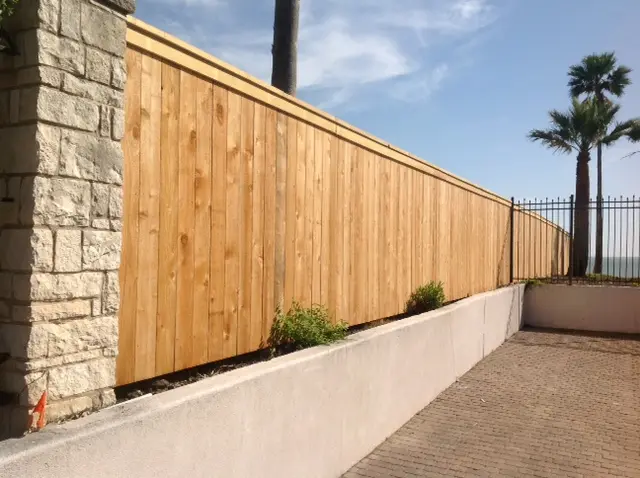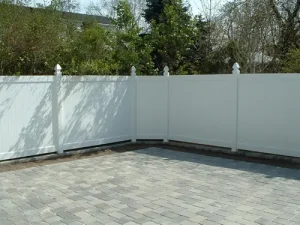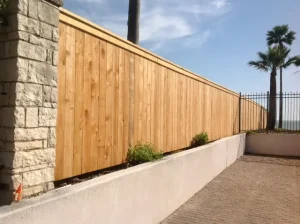![The Great Fence Debate Wood Versus Vinyl [How to Choose]](https://www.dcfence.com/wp-content/uploads/2024/04/The-Great-Fence-Debate-Wood-Versus-Vinyl-How-to-Choose-300x157.webp)
The Great Fence Debate: Wood Versus Vinyl [How to Choose?]
When it comes to enhancing the privacy, security, and aesthetic appeal of your home, few elements play as pivotal a role as your choice of

Wood fences are one of the most traditional and versatile types of fencing used to delineate property lines, enhance privacy, and contribute to the aesthetic appeal of homes and properties. Made from natural timber, these fences come in a variety of styles, designs, and finishes, allowing property owners to choose an option that best suits their needs and preferences.
It’s crucial to install your own wood fence. Approximately 17% of real estate disputes involve boundary issues, including disagreements over fences and property lines, and when you build a fence, it prevents disputes with neighbors, defines legal property lines, and creates a sense of security by delineating a private space.
Additionally, well-designed fence rails with pressure-treated wood add curb appeal and potentially increase property value, making them a sound investment for homeowners seeking both functionality and style.
Wood is one of the most popular materials for fencing due to its natural beauty, flexibility, and durability. It’s crucial to understand the properties that make wood suitable for fencing to select the right type for your needs.
Wood’s strength, durability, resistance to decay, and ease of customization are critical properties that impact its performance as a fence material. Different treatments can enhance these properties, making wood more resistant to insects, moisture, and weather changes.
Certain types of wood, like cedar and redwood, are inherently strong and can withstand harsh weather conditions and the test of time. The strength of wood determines its ability to hold up under stress and wear.
Wood’s susceptibility to decay varies significantly among species. Some woods have natural oils that repel water and pests, increasing their longevity when used in fencing.
Wood can easily be cut, shaped, and styled to fit any design preferences. This makes it an excellent option for customized fencing solutions.
Known for its rich color and natural scent, cedar is resistant to decay and insects, making it a top choice for fences.
Valued for its beauty and durability, redwood also possesses natural resistance to moisture, decay, and insects.
Often treated with preservatives, pine is an affordable option for fencing, offering durability and resistance to decay when properly maintained.
A more economical choice, spruce is commonly used in prefabricated fence post panels. It requires regular maintenance and treatment to extend its life.
Understanding these aspects of wood can guide you in selecting the most appropriate type for your fence gate, ensuring a balance between aesthetics, functionality, and longevity.
Before you start to build a wood fence, the initial step involves a thorough assessment of your property’s needs. This includes determining the function of the fence, whether for privacy, security, or aesthetic purposes, which in turn influences the design and type of wood used.
Following this, setting a realistic budget and timeline is crucial, as it helps in managing expectations and ensuring the smooth execution of building your own fence.
This stage will require you to factor in the cost of materials, labor (if you’re not undertaking the project yourself), and any unforeseen expenses.
Lastly, obtaining necessary permits is an indispensable part of the planning process. Depending on your location, local building codes and regulations may stipulate specific requirements for the height of fence pickets, design, and materials.
Ensuring compliance with these regulations can prevent legal issues and potential fines, making this step vital in the preparatory phase of your fence installation project.
When planning for wood fencing, it is crucial to consider several design elements that will not only meet your functional needs but also complement the aesthetic of your property.
The style of your fence should align with the architectural design of your home to create a cohesive look.
Popular styles include the classic picket fence, which adds a charming and inviting feel to your property, and the privacy fence, designed to provide seclusion and reduce noise from the surrounding area.
The purpose of your fence will largely dictate its height and length. For instance, a fence intended for privacy or security might need to be taller than one used solely for decorative purposes.
Local regulations may also influence the maximum allowable height of your fence, so it’s important to check these before proceeding with construction.
Decorative elements and add-ons can enhance the appearance of your wooden fence and provide additional functionality.
Lattice panels, post caps, and decorative cutouts are popular choices that add visual interest. Additionally, incorporating gates, benches, or trellises can increase the usability and appeal of your fenced area.
When it comes to erecting a wood fence, preparing with the right tools and materials is key to ensuring the process goes smoothly and the end result is both sturdy and aesthetically pleasing. Below is a detailed breakdown of what you’ll need to get started.
Gathering these tools and materials before you begin your project will streamline the installation process, making it faster and less stressful. Plus, being prepared minimizes the likelihood of needing to pause your work to acquire additional items.
Before you can erect your wood fence, the first crucial step is to prepare the site. This process involves clearing any vegetation and debris from the area where your fence will be built.
Overgrown grass, bushes, tree roots, and any form of debris on the ground must be removed to ensure a clean and stable foundation for your fence. Once the area is clear, the next step is marking the fence line. This is achieved by using stakes and string to outline where your fence will be erected.
It’s vital to measure and align carefully, as this will determine the straightness and overall appearance of your finished fence. Accuracy at this stage sets the stage for a successful fencing project.
The installation process of a wood fence involves several critical steps to ensure stability and longevity. It begins with Digging Post Holes, which must be deep enough to anchor the fence posts securely.
The depth typically depends on the height of the fence but generally ranges from 2 to 3 feet deep. Using a post-hole digger or an auger can greatly simplify this task, especially for longer fences.
Next, Setting Posts takes place, where each post is placed in its respective hole. It’s crucial to verify that the posts are level and properly aligned before securing them.
This is often done by filling the hole with a mix of cement and gravel and then allowing it to set according to the manufacturer’s instructions. Ensuring that posts are properly set is fundamental to the structural integrity of the fence.
Finally, the step of Attaching Rails and Panels comes into play. Rails are horizontal supports that are attached to the posts, serving as the framework to which the panels or individual fence boards are attached.
The method of attachment can vary depending on the fence design, but it usually involves screws or nails. When attaching panels, it’s important to maintain consistent spacing and alignment to achieve a visually appealing and structurally sound fence.
When constructing wood fences, gates, and entrances, not only do they serve as functional entry and exit points, but they also have the opportunity to enhance the aesthetic appeal of the fence overall.
These elements should harmonize with the design of the fence while ensuring security and privacy as required.
The design of the gate can vary widely depending on personal preference, the architectural style of the property, and the level of security desired.
Common gate designs include classic picket gates that mirror the style of picket fences, solid wood gates for heightened privacy, and decorative arched gates that add an element of sophistication.
The choice of design should complement the existing fence and property while fulfilling the intended functional needs.
The installation of gate hardware is a critical step in ensuring the durability and functionality of your gate. Select high-quality hinges and latches that are capable of withstanding the gate’s weight and usage frequency.
For security, consider adding locks or bolt systems. It is essential to ensure that all hardware is appropriately sized and positioned to prevent sagging and to allow for smooth operation.
Regular maintenance checks are recommended to adjust or replace hardware as needed, ensuring longevity and performance.
After your wood fence is meticulously installed, adding finishing touches such as staining or painting, and weatherproofing can significantly enhance its durability and aesthetic appeal.
Choosing between staining and painting your wood fence largely depends on the desired finish and maintenance commitments.
Staining emphasizes the natural beauty of the wood grain, offering a more rustic look, and requires less upkeep over time compared to painting. Paint, on the other hand, provides a wider range of color options and a protective film over the wood, but it may need more frequent touch-ups due to chipping or peeling.
Weatherproofing your wood fence is crucial to protect it from the elements, such as rain, snow, and intense sun exposure, which can lead to warping, rotting, or fading.
Applying a high-quality sealant not only extends the life of your fence but also preserves its appearance. For best results, it’s recommended to reapply the sealant every two to three years, depending on the climate and the specific conditions your fence is exposed to.
Maintaining your wood fence is crucial for ensuring its longevity and keeping it looking great. A well-maintained fence can last from 15 to 20 years, and sometimes even more. Regular inspections, cleaning, and repairs form the backbone of a comprehensive maintenance routine.
Periodically inspect your fence for signs of damage such as loose boards, rot, or termite presence. Early detection of these issues is key to preventing more extensive, and expensive, repairs down the line.
Pay particular attention to areas near the ground and other spots prone to moisture, as these are most susceptible to decay.
A gentle cleaning with a power washer or a simple solution of soap and water can remove dirt, mold, and mildew, revitalizing the appearance of your fence. However, it’s important to use a low setting on a power washer to avoid damaging the wood.
If you discover any damaged areas during your inspections or cleaning, address these promptly. Repairs might range from replacing individual boards to reinforcing sections of the fence to ensure it remains stable and secure.
Regular care not only extends the life of your wood fence but also maintains its aesthetic appeal, contributing positively to the overall look of your property.
A well-thought-out landscape around your wood fence not only enhances the overall aesthetic of your property but can also contribute to the longevity of the fence itself.
When considering planting near your fence, opt for shrubs, flowers, and trees that have shallow root systems to avoid damaging the fence structure over time. Utilizing native plants can add beauty and provide a low-maintenance landscape that supports local wildlife.
However, it’s crucial to be mindful of how close you are to the fence. Plants that require heavy watering can introduce excess moisture to the wood, potentially leading to rot or mold.
Similarly, vines, while attractive, can add weight and moisture, weakening the fence over time. Ideally, keep plants at least 2-3 feet away from the fence to promote air circulation and reduce maintenance requirements, ensuring that your wooden barrier stands strong and beautiful for years to come.
When planning to construct a wood fence, understanding the financial aspects is crucial for a successful project. Budgeting effectively requires a thorough consideration of both materials and labor costs, which can vary widely depending on the type of wood, the size of the area to be fenced, and the complexity of the design.
Materials typically account for a large portion of the budget. The choice of wood—whether you opt for a more affordable option like pine or a premium choice like cedar—affects not only aesthetics and durability but also cost.
Additionally, factors such as the height of the fence and the inclusion of any custom features (e.g., gates, decorative elements) will influence the overall materials expense.
Labor costs can be just as variable. If you decide to hire professionals, their rates will depend on the complexity of the installation and the geographical location. Some contractors charge per linear foot, while others may offer a flat rate for the project.
To keep expenses manageable, consider these strategies:
By carefully planning and employing these cost-saving measures, you can build a beautiful wood fence that meets your needs without breaking the bank.
Wood fences offer the dual benefits of aesthetic appeal and functionality, providing privacy and security to your property. They are environmentally friendly and can be more cost-effective than other materials.
However, drawbacks include their susceptibility to weathering, and pest invasion, and requiring regular maintenance to maintain their appearance and integrity.
The longevity and effectiveness of your wood fence heavily rely on proper installation and ongoing maintenance. This involves correct post-setting, applying protective finishes, and regular inspections for potential damages.
Properly installed and maintained wood fences can significantly enhance the beauty and value of your property, serving as a testament to the importance of diligence from the outset of your fencing project.
By submitting, you agree to receive emails from Uscreen and to our privacy policy.
![The Great Fence Debate Wood Versus Vinyl [How to Choose]](https://www.dcfence.com/wp-content/uploads/2024/04/The-Great-Fence-Debate-Wood-Versus-Vinyl-How-to-Choose-300x157.webp)
When it comes to enhancing the privacy, security, and aesthetic appeal of your home, few elements play as pivotal a role as your choice of

PVC (Polyvinyl Chloride) fencing is a type of synthetic plastic fence that offers a modern alternative to traditional materials like wood and metal. Distinguished by

Wood fences are one of the most traditional and versatile types of fencing used to delineate property lines, enhance privacy, and contribute to the aesthetic
Complete the form below and a representative will contact you shortly.